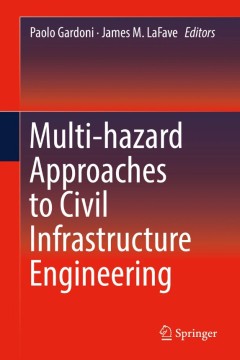Filter by

Encyclopedia of Analytical Surfaces
This encyclopedia presents an all-embracing collection of analytical surface classes. It provides concise definitions and description for more than 500 surfaces and categorizes them in 38 classes of analytical surfaces. All classes are cross references to the original literature in an excellent bibliography. The encyclopedia is of particular interest to structural and civil engineers and serve…
- Edition
- -
- ISBN/ISSN
- 978-3-319-11773-7
- Collation
- Original Russian edition published by URSS/Librokom, 2010
- Series Title
- -
- Call Number
- -

Multi-hazard Approaches to Civil Infrastructure Engineering
This collection focuses on the development of novel approaches to address one of the most pressing challenges of civil engineering, namely the mitigation of natural hazards. Numerous engineering books to date have focused on, and illustrate considerable progress toward, mitigation of individual hazards (earthquakes, wind, and so forth.). The current volume addresses concerns related to overal…
- Edition
- 1
- ISBN/ISSN
- 978-3-319-80633-4
- Collation
- IX, 573
- Series Title
- -
- Call Number
- -

Smart Cities and Construction Technologies
This book includes nine chapters presenting the outcome of research projects relevant to building, cities, and construction. A description of a smart city and the journey from conventional to smart cities is discussed at the beginning of the book. Innovative case studies of underground cities and floating city bridges are presented in this book. BIM and GIS applications on different projects, a…
- Edition
- -
- ISBN/ISSN
- 9781838801991
- Collation
- -
- Series Title
- -
- Call Number
- -

Rethinking IT in Construction and Engineering: Organisational Readiness
How could the potential of IT be realised to improve business performance in architecture, construction and engineering organisations? How could organisations unleash the potential of IT to achieve a sustainable competitive advantage? How can organisations migrate from technology to IT-enabled business thinking?Based on the author's twenty years research experience, this book provides a holisti…
- Edition
- -
- ISBN/ISSN
- 9781134085866
- Collation
- -
- Series Title
- -
- Call Number
- -

Environmental Management in Construction: A Quantitative Approach
Demands on the construction industry are changing, and it is now virtually essential for environmental management to be considered at all stages of a project. Many construction managers are finding a quantitative approach useful, and this book outlines four quantitative methods which can be applied at different construction stages, and which fit within a comprehensive framework of dynamic Envir…
- Edition
- -
- ISBN/ISSN
- 9781134198849
- Collation
- -
- Series Title
- -
- Call Number
- -
 Computer Science, Information & General Works
Computer Science, Information & General Works  Philosophy & Psychology
Philosophy & Psychology  Religion
Religion  Social Sciences
Social Sciences  Language
Language  Pure Science
Pure Science  Applied Sciences
Applied Sciences  Art & Recreation
Art & Recreation  Literature
Literature  History & Geography
History & Geography